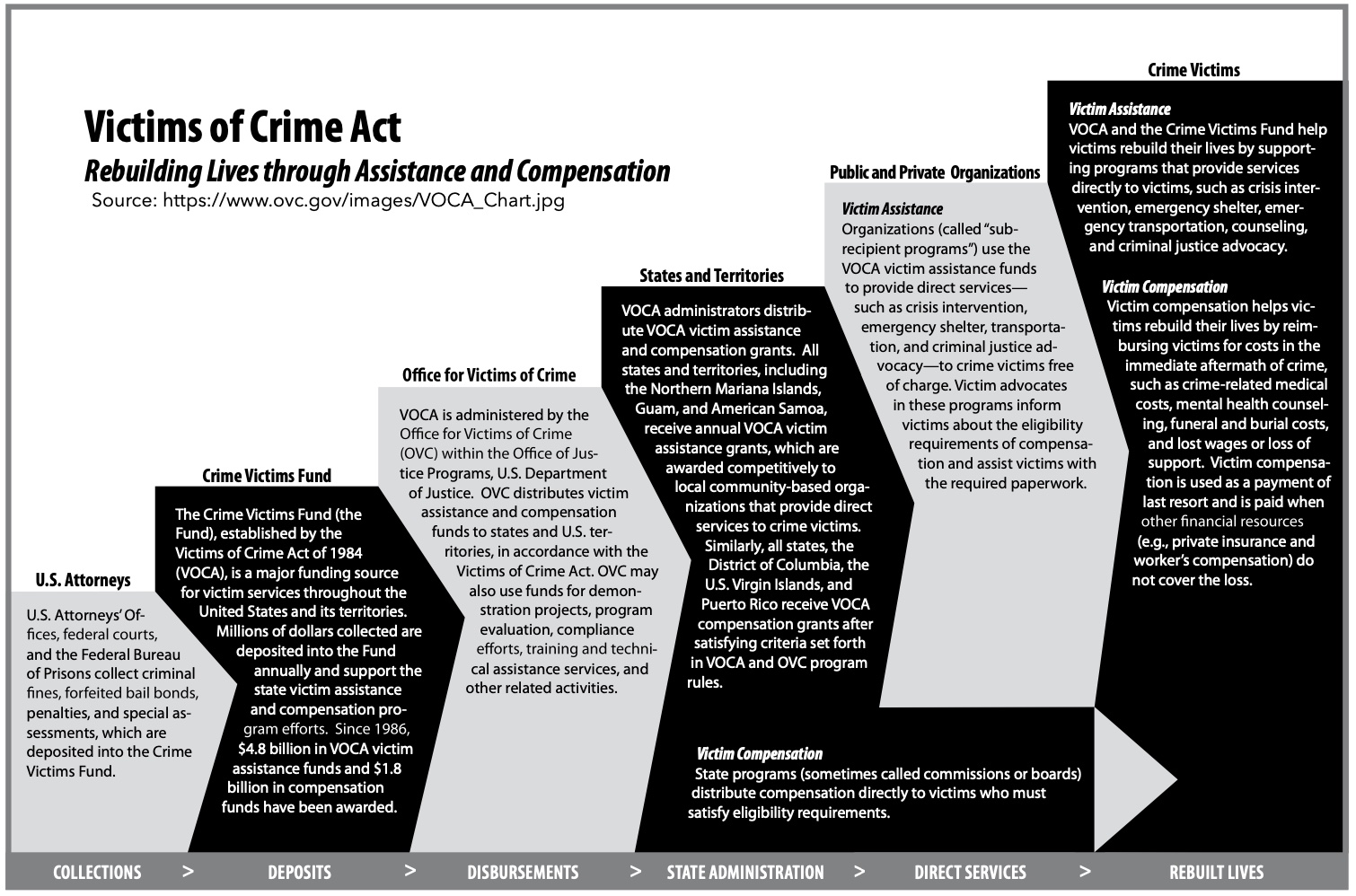The Victims of Crime Act
The Victims of Crime Act (VOCA) was enacted in 1984 and established the Crime Victims Fund (CVF or Fund). The CVF is unique in that it is funded only through the collection of criminal fines, forfeited appearance bonds, penalties, and assessments. These dollars derive from offenders convicted of federal crimes and resulting fines and penalties, not taxpayers. While Congress does not appropriate funds for VOCA, it does determine how much can be released or distributed each year from the CVF. The 2013 balance of the CVF was over $13 billion.
Overview

The idea behind the Act was that the money collected by the government from criminals should be utilized to help victims of their crimes. VOCA dollars are primarily distributed to support two important types of programs:
- Crime victim compensation programs, which pay many of the out-of-pocket expenses incurred by victims as a result of crime (including medical costs, mental health counseling, funeral and burial costs, and lost wages or loss of support), and
- Victim assistance programs, which provide victims with support and guidance in the aftermath of crime (including but not limited to crisis intervention, counseling, emergency shelter, criminal justice advocacy, and emergency transportation).
Each state and territory is recognized under VOCA to receive a dedicated annual amount for the above purposes. Formula grants to all states and territories are based largely on population. Of the amount available for state victim assistance grants, each state receives a base amount of $500,000 ($200,000 for territories) and the remainder proportional to population.
VOCA Generally Not Available to Indian Tribes
Unlike states and territories, tribes were not included in the 1984 VOCA legislation. As a result, there is no dedicated tribal funding stream under the VOCA for Indian tribes to administer to compensate and provide assistance to tribal victims of crime. Rather, tribes must access these funds through one of two grant sources. The first is what is known as a pass-through from the state where the tribe is located. The second is by competing for very limited grant resources administered by the Department of Justice under the Children’s Justice Act and OVC discretionary grants. These small, discretionary grant programs cannot be compared to the current state formula program.
Key Issues for Tribes
Since 2003, the NCAI Task Force has recommended that Congress create a funding stream within the CVF for Indian tribes. American Indian and Alaska Natives experience the highest crime victimization rates in the country, yet are largely left out of the programs funded through the VOCA. The NCAI resolution expressed the following concerns based on information from the United States Department of Justice:
- Between the years of 2011–2014, programs that served American Indians/Alaska Native survivors of violent crime received less than 0.5% of the CVF annually.
- In 2013, more than 60% of states with Indian tribes did not make a single subgrant, meaning that Native communities and survivors of violent crime received little assistance, none of which was likely to be culturally relevant or competent.
Currently, a Dear Colleague Letter for a tribal dedicated funding stream under VOCA is being led by Senators Mike Crapo and Dianne Feinstein. The VOCA Dear Colleague Letter asks that appropriators establish a funding stream for tribes. For the last three years, Congress has considered amending the VOCA. In 2015, Senators John Barrasso and Jon Tester and other bipartisan senators on the Indian Affairs Committee introduced the SURVIVE Act to direct 5% of the overall disbursements from the CVF to tribal governments with the express purpose of meeting the needs of crime victims on tribal lands. In 2016, Representative Mike Honda (prior D-CA) and Tom Cole (R-OK) worked together to pass an amendment to the House Commerce, Justice, and Science appropriations bill for FY 2017, directing 5% of the CVF to fund tribal governments.
FY 2017 VOCA Distribution Is $2.5 Billion
During the past two years, Congress has more than tripled outlays from the CVF, which reflects Congress’s commitment to provide services to victims of crime. For FY 2017, the VOCA cap was set at $2.5 billion. Even with the documented efforts above, the FY 2017 distribution did not include a dedicated stream for tribes. However, tribes and American Indian/Alaska Native survivors have not been given any access to these increases.





